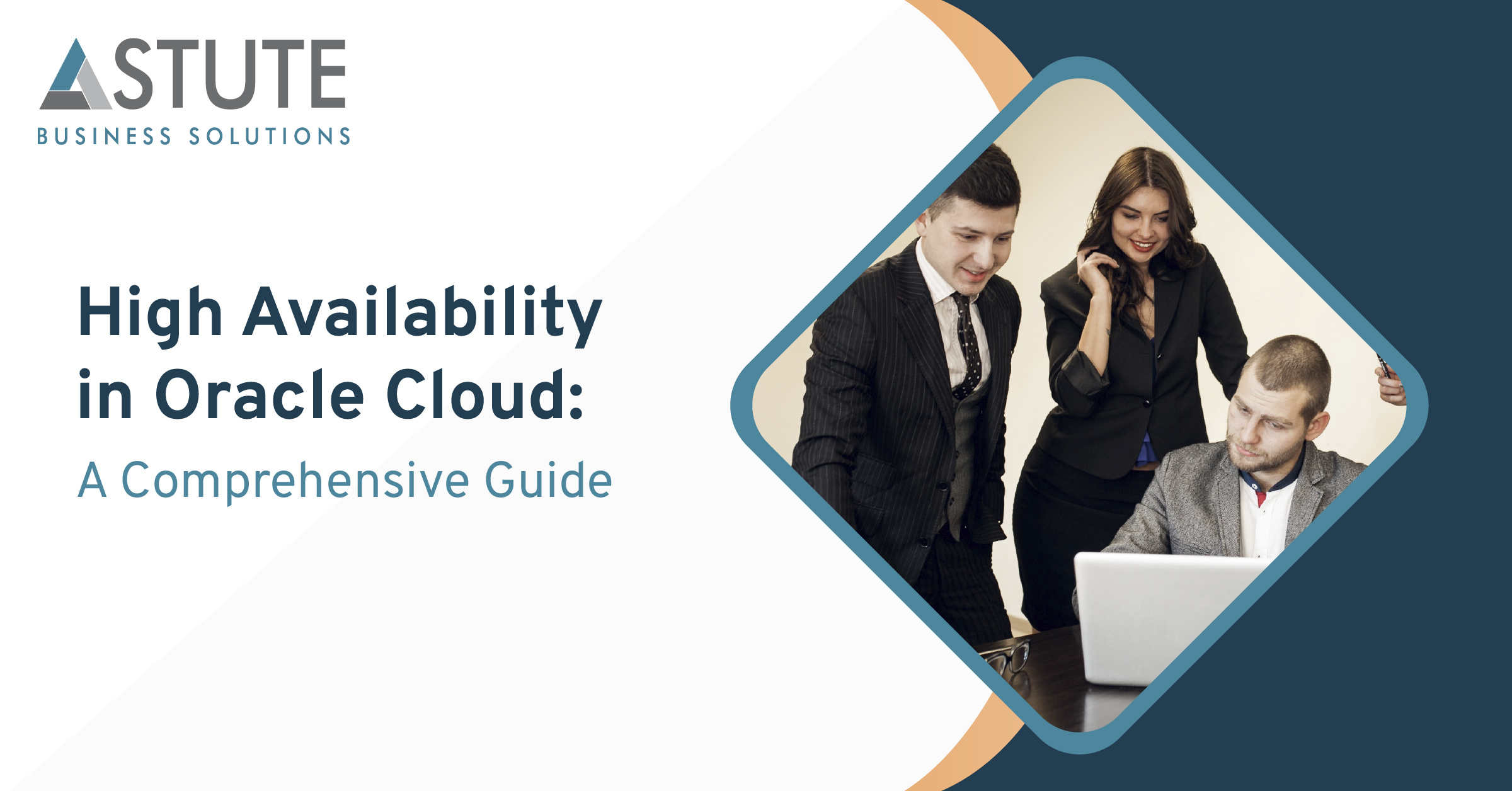
High Availability in Oracle Cloud: A Comprehensive Guide
Table of Contents
High Availability (HA) is a critical aspect of any modern IT infrastructure, ensuring continuous operations and minimizing downtime. In the context of Oracle Cloud Infrastructure (OCI), achieving high availability requires a strategic approach leveraging the cloud's features and services. This blog post aims to provide a comprehensive guide on how to architect and implement a highly available infrastructure in Oracle Cloud.
High Availability in OCI
An Oracle Cloud Infrastructure region is a localized geographic area composed of one or more availability domains, each consisting of three fault domains.
Oracle Cloud Infrastructure Regions and Availability Domains:
- An availability domain is one or more data centers located within a region. They are isolated from each other, fault-tolerant, and unlikely to fail simultaneously. Because availability domains do not share physical infrastructure, such as power or cooling or the internal availability domain network, a failure that impacts one availability domain is unlikely to impact the availability of others.
- A fault domain is a grouping of hardware and infrastructure within an availability domain. Each availability domain contains three fault domains. Fault domains let you distribute your instances so that they are not on the same physical hardware within a single availability domain. As a result, an unexpected hardware failure or Compute hardware maintenance that affects one fault domain does not affect instances in other fault domains. You can optionally specify the fault domain for a new instance at launch time, or you can let the system select one for you.
- All the availability domains in a region are connected to each other by a low-latency, high-bandwidth network. This predictable, encrypted interconnection between availability domains provides the building blocks for both high availability and disaster recovery.
- Distribute resources across multiple availability domains for fault tolerance.
Achieve Maximum Uptime With OCI's High Availability Solutions.
Businesses can discover the key strategies to ensure that applications remain available and resilient with Oracle Cloud Infrastructure.
Designing Redundancy and Resilience
Redundancy and Resilience are achieved in OCI using the below controls:
- Redundancy means that multiple components can perform the same task. This eliminates the problem of a single point of failure because redundant components can take over a task performed by a component that has failed.
- Monitoring means checking whether or not a component is working correctly.
- Failover is the process by which a secondary component becomes primary when the primary component fails.
- Implement redundant components to ensure that failures in one part of the infrastructure do not disrupt operations.
- Achieving high availability is to deploy Compute instances that perform the same tasks across multiple availability domains. This design removes a single point of failure by introducing redundancy across data centers.
- Utilize Load Balancers for distributing traffic across multiple instances.
Automated Scaling:
- Leverage OCI's Auto Scaling to adjust the number of compute instances based on workload dynamically.
- Implement policies to handle varying traffic loads seamlessly.
Network High Availability:
To plan for high availability of your network resources, the key design strategies you should consider are:
- Determine the right size of your network's subnets. Each subnet in a VCN consists of a contiguous range of IP addresses that do not overlap with other subnets in the VCN (for example, 172.16.1.0/24). The first two IP addresses and the last one in the subnet's CIDR are reserved by the Oracle Cloud Infrastructure Networking service. You can't change the size of the subnet after it is created, so it's essential to determine the size you need before making any subnets. Consider the future growth of your workloads and leave sufficient capacity to meet high availability requirements, such as the need to set up standby Compute instances.
- Plan high availability configurations for these key components: Load Balancers, IPSec VPN Connections, and FastConnect Circuits.
- Consider using redundant hardware and network service providers between your location and Oracle’s data centers. The most robust option is to use multiple FastConnect connections with circuits from different network service providers. To achieve high availability for your network, we recommend the following best practices:
- Schedule regular maintenance by Oracle, your provider, or your organization.
- Avoid single points of failure, even if you are planning to use multiple interfaces for availability. High-availability connections require redundant hardware, even when connecting from the same physical location.
- Consider a dual-provider approach to ensure network diversity when selecting FastConnect providers.
- Provision sufficient network capacity to ensure that the failure of one network connection doesn’t overwhelm and degrade redundant connections.
Database High Availability:
To plan for high availability of your databases, the key design strategies you should consider are:
- Use these key tools: Exadata Database systems, 2-Node RAC DB Systems, and Data Guard.
- Exadata Database System consists of a quarter rack, half rack, or full rack of Compute nodes and storage servers, tied together by a high-speed, low-latency InfiniBand network and intelligent Exadata software. You can configure automatic backups, optimize for different workloads, and scale up the system to meet increased demands.
- Exadata DB systems provide built-in high availability capabilities. All the existing best practices with your on-premises Exadata DB systems are applicable.
- Oracle Cloud Infrastructure offers 2-node RAC DB Systems on virtual machine Compute instances. These systems provide built-in high availability capabilities, so we recommend them for business solutions that require high availability.
- For solutions with a single-node DB system, use Oracle Data Guard to achieve high availability. Data Guard ensures high availability, data protection, and disaster recovery for enterprise data.
- Explore options for database backups and recovery.
Want to boost your cloud infrastructure’s reliability?
Consider Oracle Cloud Infrastructure (OCI) to achieve high availability and deploy compute instances that accomplish the same tasks in multiple availability domains.
Fault-Tolerant Networking:
- Utilize Virtual Cloud Networks (VCNs) with redundant components.
- Implement DNS Failover to redirect traffic in case of a failure.
Storage Redundancy:
The Oracle Cloud Infrastructure Block Volume service lets you dynamically provision and manage block storage volumes. You can create, attach, connect, and move volumes, as well as change volume performance, as needed, to meet your storage, performance, and application requirements.
- The Oracle Cloud Infrastructure Block Volume service offers a high level of data durability compared to standard, attached drives. All volumes are automatically replicated for you, helping to protect against data loss. Multiple copies of data are stored redundantly across multiple storage servers with built-in repair mechanisms.
- Implement redundant storage options, such as Block Volumes with automatic backups.
- The Block Volume service provides you with the capability to perform ongoing automatic asynchronous replication of block volumes and boot volumes to other regions or availability domains within the same region. Cross-availability domain replication within the same region is only supported for regions with more than one availability domain.
Monitoring and Alerting:
- Set up monitoring and alerting using OCI Monitoring and Notifications.
- Define thresholds and triggers for automated responses to potential issues.
Compliance and Security:
- Ensure that high availability measures align with industry compliance standards.
- Implement security best practices to protect highly available resources.
Conclusion
High Availability in Oracle Cloud Infrastructure is not just a feature; it's a design philosophy that should be ingrained in every aspect of your cloud architecture. By leveraging OCI's robust features and services, distributing resources strategically, and implementing redundancy and automation, organizations can achieve the level of availability required for their critical workloads. Remember, high availability is an ongoing process that involves continuous testing, improvement, and adaptation to evolving business needs and technological advancements.
Astute is an Oracle-certified solutions partner to help customers streamline their business processes with automated solutions, high availability of network and databases, high-tech security, and many more.
Search
Tags
Related Posts
Subscribe Our Newsletter
Gain access to exclusive insights, technical know-how and crucial knowledge from Astute experts.
Share Article
See The Team In Action
Upcoming Events
-1.png)
Reach Out
Ready to Connect?
Please fill the following form, we will get back to you within a business day.
Contact Form
Contact Us



